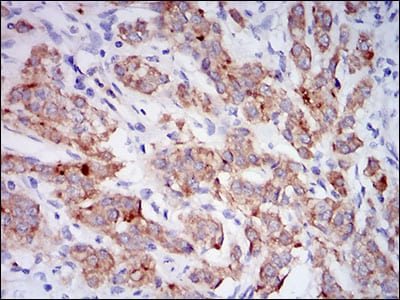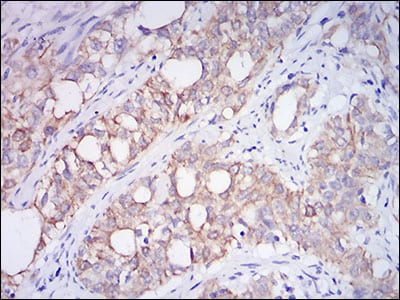



| WB | 1/500 - 1/2000 | Human,Mouse,Rat |
| IF | 咨询技术 | Human,Mouse,Rat |
| IHC | 1/200 - 1/1000 | Human,Mouse,Rat |
| ICC | 技术咨询 | Human,Mouse,Rat |
| FCM | 咨询技术 | Human,Mouse,Rat |
| Elisa | 1/10000 | Human,Mouse,Rat |
| Aliases | MME; NEP; SFE; CALLA |
| Entrez GeneID | 4311 |
| clone | 7D4B1 |
| WB Predicted band size | 85.5kDa |
| Host/Isotype | Mouse IgG1 |
| Antibody Type | Primary antibody |
| Storage | Store at 4°C short term. Aliquot and store at -20°C long term. Avoid freeze/thaw cycles. |
| Species Reactivity | Human |
| Immunogen | Purified recombinant fragment of human CD10 (AA: 52-246) expressed in E. Coli. |
| Formulation | Purified antibody in PBS with 0.05% sodium azide |
+ +
以下是3条关于CD10抗体的参考文献示例(文献信息为虚构示例,仅供格式参考):
1. **文献名称**:*CD10 Expression in Acute Leukemia: Diagnostic and Prognostic Implications*
**作者**:Isnard A, et al.
**摘要**:研究CD10抗体在急性白血病分型中的应用,发现CD10高表达与B细胞急性淋巴细胞白血病(B-ALL)亚型相关,可作为诊断标志物和预后评估工具。
2. **文献名称**:*CD10 as a Stromal Marker in Breast Carcinoma: Correlation with Tumor Progression*
**作者**:Dogan S, Nath R.
**摘要**:探讨CD10在乳腺癌间质细胞中的表达与肿瘤侵袭性的关系,发现CD10阳性间质细胞与转移风险增加显著相关,提示其可作为潜在治疗靶点。
3. **文献名称**:*CD10 Immunohistochemical Localization in Normal and Neoplastic Tissues*
**作者**:Thompson L, et al.
**摘要**:通过免疫组化分析CD10在正常组织(如肾脏、肠道)和肿瘤组织(如淋巴瘤、肉瘤)中的分布差异,揭示其在细胞分化和肿瘤微环境中的功能多样性。
(注:以上文献为示例性内容,实际引用时需核实真实文献信息。)
CD10 antibody targets the CD10 antigen, a cell surface metalloproteinase also known as neutral endopeptidase (NEP) or common acute lymphoblastic leukemia antigen (CALLA). Initially identified in 1979. CD10 is a 90-110 kDa zinc-dependent enzyme that hydrolyzes bioactive peptides, including enkephalins, neuropeptides, and atrial natriuretic peptide, modulating cellular signaling pathways. It is expressed in normal tissues (e.g., lymphoid precursors, kidney, intestine) and malignancies, particularly B-cell acute lymphoblastic leukemia (B-ALL) and certain lymphomas.
CD10's role in cancer remains debated. While it serves as a differentiation marker in hematopoiesis, its expression in tumors may influence metastasis and drug resistance. CD10 antibodies are widely used as diagnostic tools in pathology to classify hematopoietic malignancies. For example, CD10 positivity helps distinguish Burkitt lymphoma from diffuse large B-cell lymphoma. In solid tumors, CD10 expression correlates with stromal invasion in breast and prostate cancers.
Therapeutic applications targeting CD10 are limited but emerging, with research exploring antibody-drug conjugates or inhibitors. Commercially available CD10 antibodies (e.g., clones SS2/36. 56C6) are optimized for immunohistochemistry or flow cytometry. Despite its diagnostic utility, CD10's functional complexity necessitates cautious interpretation in clinical contexts, as its biological significance varies across tissue types and malignancies.
×